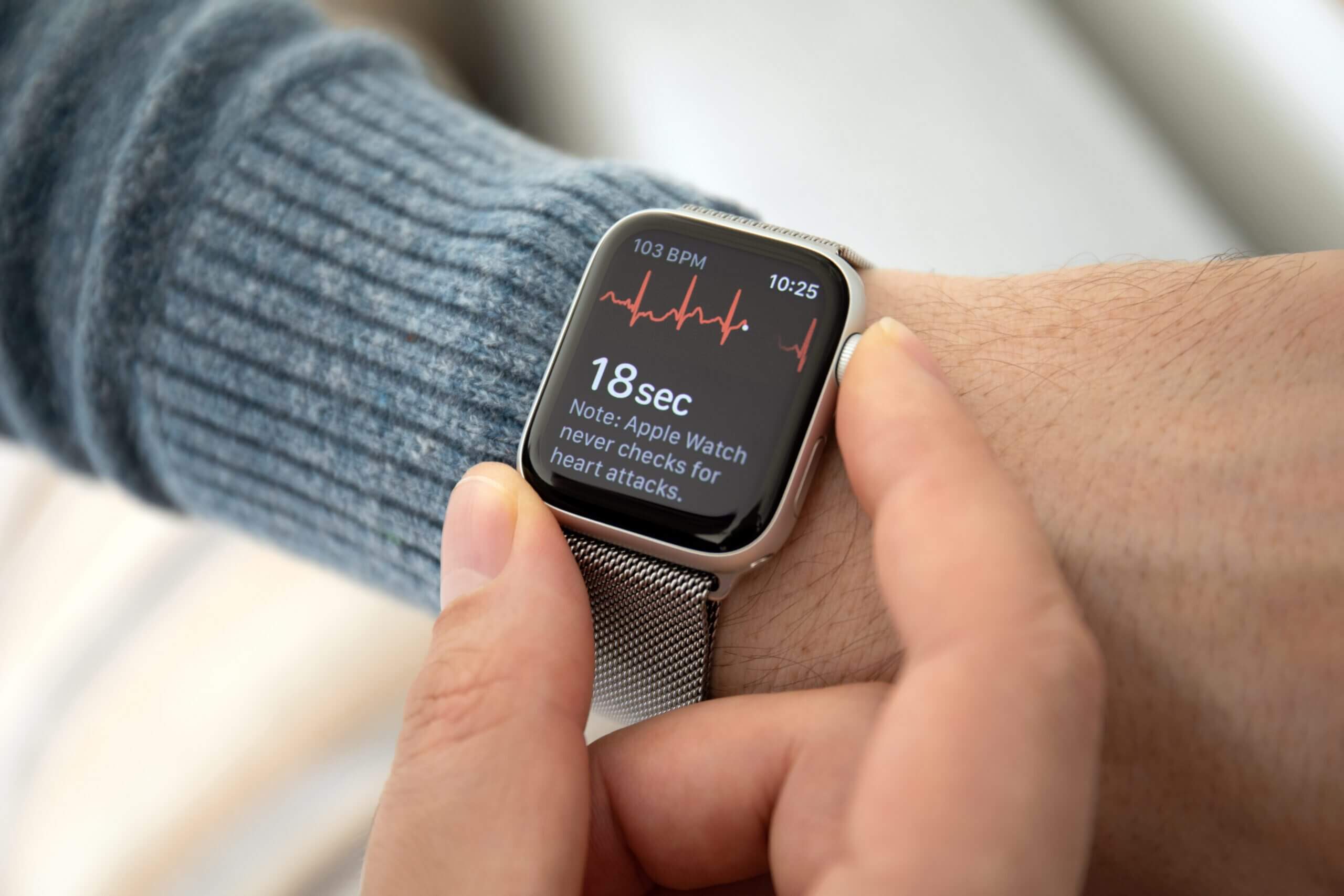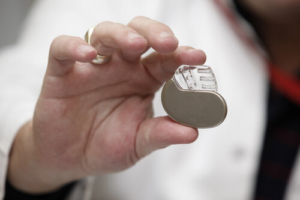Learn more about the Apple Watch and AFib in this article. The Apple Watch has become a popular gadget not only for its stylish design and seamless integration with other Apple devices, but also for its potential to help users take better care of their heart health. One such feature is its ability to detect irregular heart rhythms, which could indicate atrial fibrillation (AFib) – a common heart disorder with potentially severe consequences. But how accurate and reliable is the Apple Watch in detecting AFib? In this blog post, we will explore the capabilities of the Apple Watch, examine the accuracy of its AFib detection, discuss alternative devices, and delve into lifestyle choices that can reduce the risk of AFib. Furthermore, we will analyze the role of the “AFib Apple Watch” feature in managing heart health.
Key Takeaways
Apple Watch uses photoplethysmography (PPG) and ECG app to detect irregularities in heart rate, including atrial fibrillation (AFib).
The accuracy of the Apple Watch is inconclusive but improving with every generation of watch. The ECG app is overall more accurate then the PPG sensor. False positives may lead to unnecessary tests or treatments.
A healthy lifestyle with regular exercise, balanced diet & stress management can reduce AFib risk.
Apple Watch and AFib Detection
Atrial Fibrillation (AFib) is a common heart disorder affecting millions of Americans, primarily those over 65 years of age. Rapid heartbeat, palpitations, fatigue, chest pain, or shortness of breath can be indications of AFib, which is one of the most common abnormal heart rhythms. Take note of any changes in your health and consult your doctor if these changes continue.
The Apple Watch is capable of detecting irregular heart rhythms, including AFib, through its irregular rhythm notifications feature. This feature periodically monitors the user’s heartbeat to detect an irregular rhythm suggestive of AFib, usually when the user is at rest. Although the notification indicates a possible irregular rhythm, it’s crucial to seek professional medical advice if further symptoms develop since the Apple Watch doesn’t replace professional medical advice.
Different Apple Watch series offer varying features for heart health monitoring. Series 1 and subsequent models of the Apple Watch provide heart rate notifications and can collect health data related to heart health. The irregular rhythm notification feature is available on various Apple Watch models, including the Apple Watch SE. This notification feature could potentially signal AFib, a condition that needs early detection due to its potential to increase stroke risk and other health complications.
How Apple Watch Identifies AFib
Apple Watch uses photoplethysmography (PPG) to measure heart rate and identify irregular rhythms. PPG is a non-invasive optical technique that measures fluctuations in blood volume in the microvascular bed of tissue, allowing the calculation of the user’s heart rate. The Apple Watch utilizes this technology to:
Measure the amount of light reflected from the blood vessels in the wrist
Evaluate the data to detect any irregularities in the user’s heart rate
Identify irregular rhythms such as atrial fibrillation (AFib)
Atrial fibrillation is a type of arrhythmia that can lead to stroke, heart failure, and other serious health complications.
With the advancement in technology and the introduction of newer Apple Watch models, the ability to detect AFib has also improved. Starting with the Apple Watch Series 4, as well as more recent generations, came equipped with an electrocardiogram (ECG) app that can detect atrial fibrillation. The Series 9 is the most recent and sophisticated model, featuring the most capabilities for detecting and tracking AFib.
Apple Watch Series Comparison
For users who prioritize heart health monitoring, a comparison of different Apple Watch series based on AFib detection capabilities and other heart health features is beneficial. The Apple Watch Series 4 introduced the ECG app, capable of detecting AFib. It also includes an irregular heart rhythm notification capability that can warn users of a potential atrial fibrillation. Apple Watch Series 4 and later also include fall detection to allow faster communication with emergency medical services in case of a hard fall.
Apple Watch Series 5 and later also have an electrocardiogram app that can detect atrial fibrillation. In addition to this, the Apple Watch also introduced an irregular heart rhythm notification and a low heart rate notification for a more comprehensive monitoring experience.
The Apple Watch Series 6 introduced additional health monitoring features. It not only includes the irregular heart rhythm notification feature and the low heart rate notification feature, but also introduces a blood oxygen monitoring feature. This added feature makes the Apple Watch Series 6 an excellent choice for individuals who want to keep a close eye on their heart health and manage AFib effectively.
The Apple Watch Series 9, the latest edition of the Apple Watch, brings in advanced health features for its users. It continues to offer the ECG app and irregular rhythm notification feature for AFib detection. The Series 9 also includes a blood oxygen monitor, providing an extra layer of insight into the user’s overall health. Furthermore, this model has enhanced fitness tracking capabilities, including a more precise pedometer and an improved sleep tracking feature. Coupled with its seamless integration with the Apple Health app, the Apple Watch Series 9 offers a comprehensive health monitoring experience, making it an excellent tool for managing heart health and overall wellness.
The Apple Watch SE, while a more affordable option in the Apple Watch lineup, still offers a variety of health features. It provides heart rate monitoring, irregular rhythm notifications, and fitness tracking capabilities, allowing users to monitor their daily activity and overall heart health. The device can also detect hard falls and automatically call emergency services if the wearer is unresponsive. However, it’s important to note that the Apple Watch SE does not include the electrocardiogram (ECG) sensor, a feature available in the higher-end models that can detect atrial fibrillation (AFib).
The Accuracy of Apple Watch in Detecting AFib
Studies have shown mixed results regarding the accuracy of the Apple Watch in detecting AFib. One study by the Cleveland Clinic on hospitalized patients determined that:
The sensitivity of the Apple Watch was 41%
The overall agreement between the Apple Watch notification and telemetry was 61%
The PDF waveform from the study was proven to be more dependable for AF detection compared to the rhythm notification of a watch. Overall, the agreement between the Apple Watch–generated PDF rhythm strips and telemetry was 98.9%
Hence, for accurate detection, it’s preferable to use PDF waveforms through the ECG app over the irregular heart rhythm notifications.
Another study, the Apple Heart Study studied 419,297 participants over 8 months, in which over a median of 117 days of monitoring, 2161 participants (0.52%) received notifications of irregular pulse. Among participants who received notification of an irregular pulse, 34% had atrial fibrillation on subsequent ECG patch readings and 84% of notifications were concordant with atrial fibrillation. found that the Apple Watch had a 97% sensitivity and 99% specificity in detecting atrial fibrillation.
The disparities in sensitivity between studies suggest that additional validation is needed before this technology is widely accepted for AFib detection. I usually tell my patients that the Apple Watch can be a useful tool for at home monitoring, but does not replace the accuracy of medical grade testing from your doctor’s office.
False positives can result in unnecessary tests and heightened anxiety, thereby underscoring the need to consult a healthcare professional for accurate diagnosis. In fact, physicians should take precautionary measures before implementing action based on electrocardiographic diagnoses produced by this wrist-worn monitor.
Apple Heart Study Findings
The Apple Heart Study focused on the accuracy of the Apple Watch in detecting AFib in 419,297 participants over an 8 month period and found the following results:
The positive predictive value in participants notified of an irregular pulse was 0.84.
The algorithm used to classify electrocardiograms as sinus rhythm, atrial fibrillation, or inconclusive had a sensitivity of >98% and a specificity of >99%.
However, the study also reported a rate of unreadability of 6%.
These findings suggest that the Apple Watch can be a beneficial resource for detecting AFib; however, it is not always reliable and should be used in combination with other forms of diagnosis. The disparities in sensitivity between studies imply that additional validation is necessary before this technology is embraced by the public for AFib detection.
False Positives and Potential Risks
False positives refer to instances where a test incorrectly suggests that a condition is present when it is not. In the context of AFib detection using the Apple Watch, false positives can result in unnecessary tests and treatments, and increased anxiety for the user. These potential risks underscore the need to consult a healthcare professional for proper AFib diagnosis, testing, and management.
The accuracy of the Apple Watch in detecting AFib is still under evaluation, and users should be aware of the potential risks and limitations of using the device for medical purposes. Before making any decisions based on Apple Watch data, consulting a healthcare professional is crucial.
Managing AFib Using Apple Watch Data
Apple Watch can be a useful tool for monitoring heart health and managing AFib when used in conjunction with professional medical care. The device can be used to monitor heart rate, detect irregular heart rhythms, and alert users to potential AFib episodes. Additionally, it can track physical activity, diet, and other lifestyle factors that can assist in managing AFib.
However, the accuracy of the Apple Watch in detecting AFib is not perfect, and users should be aware of the potential risks of relying solely on the device for diagnosis and treatment.
Integrating Apple Watch data with medical care can help users manage AFib more effectively. The Apple Health app allows users to:
Store and share data with their healthcare providers, including heart rate, activity levels, and any irregular rhythms detected, including saved ECG recordings.
Use this information to inform medical decisions, provide additional insight into a patient’s health, and monitor progress.
Adjust treatment plans as necessary
Monitoring Heart Health with Apple Watch.
The Apple Watch allows users to:
Track their heart rate
Receive notifications for irregular rhythms, which can be indicative of AFib
Customize their notifications for high or low heart rates, irregular heart rhythms, and sinus rhythm abnormalities
The Apple Watch also boasts an AFib history feature, which allows users to track and monitor their AFib episodes over time. This feature records and stores instances of detected irregular heart rhythms, providing users with a historical overview of their heart health. This data can be invaluable for doctors to understand the frequency and patterns of AFib episodes, aiding in diagnosis and treatment planning.
These features provide valuable insights into the user’s heart health and can help them stay proactive in managing their AFib.
To further integrate Apple Watch data with medical care, users can share their data with healthcare providers through the Apple Health app. This allows doctors to access the user’s heart rate, activity levels, and any irregular rhythms detected, providing a comprehensive view of the patient’s heart health and helping to inform medical decisions and treatment plans.
Integrating Apple Watch Data with Medical Care
Combining Apple Watch data with medical care can help users manage their AFib and make informed decisions about their treatment. Apple Watch data can be used to monitor heart rate, detect irregular rhythms, and alert users to potential AFib episodes. This information can be used to inform medical decisions, provide additional insight into a patient’s health, and monitor progress and adjust treatment plans as necessary.
However, before making any decisions based on Apple Watch data, users should consult a healthcare professional. They should also be aware of the potential risks and limitations of using the device for medical purposes. Relying solely on Apple Watch data for diagnosis and treatment can lead to false positives or false negatives, and it is important to integrate this data with professional medical care for accurate diagnosis and management of AFib.
Important Considerations and Limitations
It is important to know that the Apple Watch cannot detect a heart attack, stroke, high blood pressure, or congestive heart failure. The Apple Watch cannot definitively diagnose heart conditions or heart rhythms – the device is to be used as a monitoring tool to provide more information to trained professionals.
Also note it is not recommended to use an ECG feature of the Apple Watch if you have a pacemaker or implanted defibrillator (ICD). In most cases, the pacemaker or ICD will cause an artifact that will result in a poor quality tracing of the ECG on the Apple Watch.
If you are feeling unwell, do not rely on the Apple Watch to diagnose your symptoms. In a true medical emergency, seek out appropriate medical attention.
Alternative Devices for AFib Detection
There are alternative devices available for AFib detection, each with its own advantages and disadvantages. Some of these devices include:
Handheld ECG recorders like Kardia Mobile by AliveCor and Zenicore EKG. Read my detailed Kardia Mobile Review here.
Patch ECG monitors like ZioPatch and MCOT Patch BodyGuardian-Heart, these are usually prescribed by your doctor’s office.
Alternative smart watches with ECG such as the Fitbit Sense Watch, the Samsung Galaxy Watch, or the Google Pixel Watch. Read more about smart watches for AFib here.
These alternative devices offer users different options for detecting AFib and managing their heart health. Comparing the pros and cons of alternative devices for AFib detection can help users make informed decisions about which device best suits their needs. Some devices may be more accurate or reliable than others, while others may be more comfortable or convenient to use.
Understanding the health benefits and drawbacks of each device will allow users to choose the best option for their lifestyle and heart health needs.
Apple Watch Versus KardiaMobile. Which Do I Usually Recommend?
Many people ask me, “What do you recommend, a KardiaMobile or an Apple Watch?” My answer is usually based on whatever features the patient is more interested in. For someone looking strictly for an at home monitor for atrial fibrillation, the KardiaMobile is what I usually recommend, plus it is much cheaper then an Apple Watch. But for someone who likes smart watch technology, who wants the messaging, phone, and music options together with AFib monitoring, then the Apple Watch can be an excellent option.
When looking for an at home monitor strictly for AFib, I typically recommend the KardiaMobile. My patients find it easy to use and the device provides good quality ECG’s; good enough that my office can determine the rhythm when sent a copy of the ECG. In addition, the multiple angle tracings provide by the KardiaMobile 6L provide even better diagnostic accuracy, especially when reviewed by your doctor’s office.
Read my popular Kardia Mobile Review article here.
Pros and Cons of Alternative Devices
Alternative devices for AFib detection, such as ECG monitors and implantable devices, have their own set of advantages and disadvantages. ECG monitors, like the Kardia Mobile, are portable and convenient for AFib screening, but they may not be as accurate as patch ECG monitors from your doctor’s office like ZioPatch and MCOT Patch BodyGuardian-Heart. Patch ECG monitors provide more precise data and in-depth information, but may be more expensive or less comfortable to wear.
Implantable devices, such as loop recorders, can effectively control AFib and decrease the risk of blood clots, providing an alternative to blood-thinning medications. However, these devices may require invasive procedures and may not be suitable for all patients. Users should carefully consider the pros and cons of each device and discuss with their healthcare provider to decide the best option for their individual needs. Read more about loop recorders for AFib here.
Lifestyle Choices for Reducing AFib Risk
Adopting a healthy lifestyle can help reduce the risk of AFib and its complications. Making healthy choices, such as engaging in regular physical activity, adhering to a balanced diet, and managing stress, can all contribute to reducing the risk of developing AFib and its associated complications.
The American Heart Association (AHA) recommends a heart-healthy lifestyle, including:
Regular aerobic exercise
Managing risk factors such as high blood pressure and cholesterol levels
Adhering to a heart-healthy diet
Abstaining from tobacco use
By following these recommendations and implementing positive lifestyle changes, users can minimize their risk of AFib and enhance their overall heart health and well-being. In general, lifestyle modifications are an important part of AFib treatment and can help improve symptoms for many patients.
The American Heart Association suggests living a heart-healthy lifestyle to reduce the risk of AFib. This entails engaging in regular aerobic exercise, which can help enhance overall cardiac health, lower blood pressure and cholesterol levels, and reduce stress. A balanced diet that includes a variety of fruits and vegetables can also assist in controlling weight and cholesterol levels, thus reducing the risk of AFib.
In addition to exercise and diet, the AHA emphasizes the importance of managing stress and abstaining from alcohol and smoking to decrease the risk of AFib. Users can reduce their risk of AFib and its complications, thereby improving their overall heart health and quality of life, by adhering to these recommendations and consciously leading a heart-healthy lifestyle.
Summary
In conclusion, the Apple Watch offers a promising tool for detecting and managing AFib, with various models providing different features for heart health monitoring. While studies have shown mixed results regarding the accuracy of the Apple Watch in detecting AFib, it is essential to remember that this technology should be integrated with professional medical care for accurate diagnosis and treatment. Alternative devices for AFib detection are available, each with its own advantages and disadvantages, and users should weigh their options carefully.
Frequently Asked Questions
Can Apple Watch detect atrial fibrillation?
The Apple Watch features the Irregular Rhythm Notification Feature (IRNF) and ECG app, both of which are designed to detect irregular heart rhythms such as atrial fibrillation (AFib).
These features are FDA-cleared and increasingly being used for AF management.
Is Apple Watch FDA approved for atrial fibrillation?
The FDA has cleared the Apple Watch for use in detecting irregular heart rhythms, including atrial fibrillation, since 2018.
It is intended to help patients with AFib track the effect of lifestyle factors on their irregular rhythm.
Is The Apple Watch ECG accurate?
Overall, the Apple Watch ECG has been found to be relatively accurate. One study demonstrated that it could accurately detect AFib in 84% of cases when compared to a traditional 12-lead ECG, while another showed it had “moderate diagnostic accuracy”.
These studies suggest that the Apple Watch ECG is a reliable tool for detecting AFib. It is also easy to use and can be used in the comfort of your home.
How does the Apple Watch detect irregular heart rhythms?
The Apple Watch uses photoplethysmography technology. a simple optical technique used to detect volumetric changes in blood, to detect irregular heart rhythms, such as AFib, by measuring heart rate.
What alternative devices are available for AFib detection?
Alternative devices for AFib detection include handheld ECG recorders, patch ECG monitors, and other wearable devices.
Does the Apple Watch detect a heart attack?
No, the Apple Watch cannot detect a heart attack. While the Apple Watch can monitor heart rhythms and detect irregularities such as atrial fibrillation (AFib), it is not designed or equipped to detect a heart attack. A heart attack occurs when the blood supply to a part of the heart is blocked, usually by a blood clot. This is a different condition from AFib, which is an irregular heart rhythm. If you experience symptoms of a heart attack, such as chest pain, shortness of breath, or pain in your arms, back, neck, jaw, or stomach, you should seek immediate medical attention.
The Best Atrial Fibrillation Book
Your Complete Guide To AFib: The Essential Manual For Every Patient With Atrial Fibrillation

Shop AFib Products on Amazon
KardiaMobile 6-Lead Personal EKG Monitor – Six Views of The Heart – Detects AFib and Irregular Arrhythmias – Instant Results in 30 Seconds – Works with Most Smartphones - FSA/HSA Eligible

KardiaMobile 1-Lead Personal EKG Monitor – Record EKGs at Home – Detects AFib and Irregular Arrhythmias – Instant Results in 30 Seconds – Easy to Use – Works with Most Smartphones - FSA/HSA Eligible

Apple Watch Series 9 [GPS 41mm] Smartwatch with Storm Blue Aluminum Case with Silver Sport Band M/L. Fitness Tracker, Blood Oxygen & ECG Apps, Always-On Retina Display

Fitbit Sense 2 Advanced Health and Fitness Smartwatch with Tools to Manage Stress and Sleep, ECG App, SpO2, 24/7 Heart Rate and GPS, Shadow Grey/Graphite, One Size (S & L Bands Included)

OMRON - Complete Wireless Upper Arm Blood Pressure Monitor + EKG - Built-in Bluetooth Technology
27% Off
Omron Hem 7361T Bluetooth Digital Blood Pressure Monitor with Afib Indicator and 360° Accuracy Intelliwrap Cuff for Most Accurate Measurements (White)

EMAY Portable ECG Monitor | Record ECG and Heart Rate Anytime Anywhere | Stand-Alone Device with LCD Screen and Storage | No Subscription Required

SAMSUNG Galaxy Watch 6 44mm Bluetooth Smartwatch, Fitness Tracker, Personalized HR Zones, Advanced Sleep Coaching, Heart Monitor, BIA Sensor, Health Wellness Insights, Big Screen, US Version, Graphite

Natural Rhythm Triple Calm Magnesium 150 mg - 120 Capsules – Magnesium Complex Compound Supplement with Magnesium Glycinate, Malate, and Taurate. Calming Blend for Promoting Rest and Relaxation.

Pure Encapsulations Magnesium (Glycinate) - Supplement to Support Stress Relief, Sleep, Heart Health, Nerves, Muscles, and Metabolism* - with Magnesium Glycinate - 180 Capsules


















![Apple Watch Series 9 [GPS 41mm] Smartwatch with Storm Blue Aluminum Case with Silver Sport Band M/L. Fitness Tracker, Blood Oxygen & ECG Apps, Always-On Retina Display #1](https://m.media-amazon.com/images/I/311xwtp4mFL._SL100_.jpg)
![Apple Watch Series 9 [GPS 41mm] Smartwatch with Storm Blue Aluminum Case with Silver Sport Band M/L. Fitness Tracker, Blood Oxygen & ECG Apps, Always-On Retina Display #2](https://m.media-amazon.com/images/I/41j+8AaUGsL._SL100_.jpg)
![Apple Watch Series 9 [GPS 41mm] Smartwatch with Storm Blue Aluminum Case with Silver Sport Band M/L. Fitness Tracker, Blood Oxygen & ECG Apps, Always-On Retina Display #3](https://m.media-amazon.com/images/I/41jIyxZitnL._SL100_.jpg)
![Apple Watch Series 9 [GPS 41mm] Smartwatch with Storm Blue Aluminum Case with Silver Sport Band M/L. Fitness Tracker, Blood Oxygen & ECG Apps, Always-On Retina Display #4](https://m.media-amazon.com/images/I/41IpNJERjCL._SL100_.jpg)
![Apple Watch Series 9 [GPS 41mm] Smartwatch with Storm Blue Aluminum Case with Silver Sport Band M/L. Fitness Tracker, Blood Oxygen & ECG Apps, Always-On Retina Display #5](https://m.media-amazon.com/images/I/31o17yhfYpL._SL100_.jpg)

















































